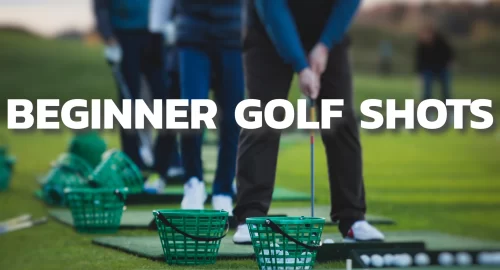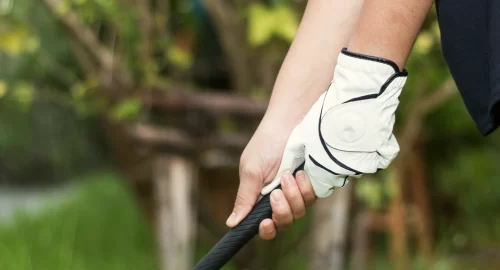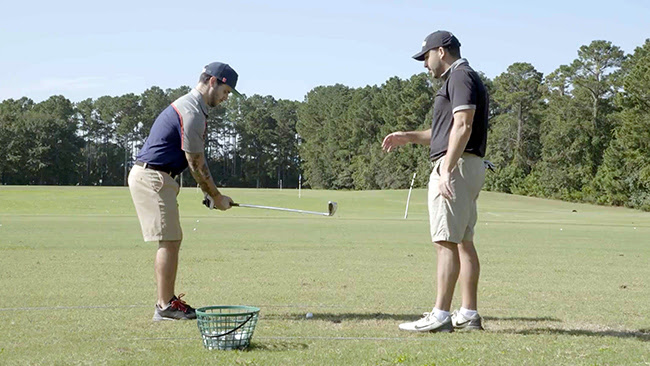
In golf, it’s rare to hit a shot that flies perfectly straight.
Even accurate shots that find the target usually curve a little to the left (a draw, for a right-handed golfer) or to the right (a fade).
Let’s take an in-depth look at draw vs. fade in golf – the what, how, the benefits and downsides of each.
All examples are from a right-handed golfer’s perspective; if you’re a lefty, simply reverse the direction.
Table Of Contents
- Golf for Beginners: The Basics
- The Rules Of Golf
- Golf Etiquette: The Basics
- Golf Clubs For Beginners: All You Need To Know
- Golf Balls for Beginners: All You Need To Know
- How To Play Golf for Beginners: The Learning Part
- The Golf Course: How Do I Know I’m Ready For My First Round?
- Golf Lessons: Do You Need Them?
- Conclusion & Key Takeaways
- Golf for Beginners: FAQs
Learning how to play golf can be confusing, intimidating, and even a little embarrassing.
There’s an abundance of information on how to swing the club, what equipment to use, and for following the correct etiquette.
Yet golf is easiest and most enjoyable when kept simple – especially when you’re a beginner.
Which is why we created this guide, revealing our most-coveted golf tips to help you develop a reliable swing, make rapid progress, and get you on the golf course with confidence…
Without being overwhelmed or breaking the bank.
Golf for Beginners: The Basics
What Equipment You Need to Play Golf
We’ll cover what golf clubs and balls you need, in detail, shortly. So for now, here’s the other equipment you’ll need to get round the course:
A Golf Bag
To carry your clubs in (obviously!)
Tees
For teeing up the ball on your tee shots.
Typically tees are wooden or plastic and come in various sizes. They’re pretty cheap, so pick up a few bags and figure out which ones you like best.
Divot Tool
To repair marks on the green from your approach shots.
You might not need to use this too much when beginning, but when you do, it’ll go a long way to getting on your playing partners’ good side.
Ball Marker
For marking your ball on the green if you’re in someone else’s putting line.
Golf Glove
To improve the grip of your lead hand (your non-dominant hand) on the golf club
Golf Shoes
For improved traction when the ground is wet.
A Towel
To keep your clubs clean.
Playing Golf Solo or In a Group: What’s Best for You
We always recommend playing with a more experienced friend when starting out, if possible.
This will help you understand the basics golf etiquette, keep up with the pace of play, and learn useful golf tips for beginners.
However, if you’d rather play alone, or don’t have anyone to play with, try to play the course when it’s quiet. This way you can take your time without the worry that others are watching.
How Long Does a Round of Golf Take?
The length of a golf round varies widely depending on several factors, including: your group size, how well you’re playing that day, the golfing format you’re playing e.g stroke play (1) vs foursomes, etc.
However, you can expect to be on the course anywhere between 3 to 5 hours when playing 18 holes.
What You Must Know About Golf Courses – (size, number of holes, private vs. public, etc.)
Some golf courses are more beginner-friendly than others – in terms of, both, difficulty and accessibility.
The good news is, there isn’t a lack of courses to choose from, as around 75% of all US golf courses are publicly available (2).
But just because a course is accessible or local, doesn’t necessarily mean it’s the best one to play as a beginner.
When starting out, you should look to play a course that’s around 4,000 – 5,500 yards from one of the forward tee boxes.
Even better, look for 9-hole par 3s, or short executive courses. These courses will allow you to get in a good amount of practice in half the time it’d take to get round a full 18 hole course.
Finally, try to play courses that are less expensive. Not only are they more forgiving on your bank account, they’re also more forgiving on your game. And there’s no point playing expensive, tournament level courses that are so difficult that you consider giving up golf before you’ve even started!
A Few Words On The Golf Dress Code
There is no one fixed golf dress code.
Each golf club determines what attire is acceptable on their course (and in their clubhouse).
Typically, the more exclusive the club, the more strict the dress code.
It’s always a good idea to call ahead or check the club’s website before turning up to play, but if you’re ever in doubt, you can’t go wrong with:
- A hat or a cap
- A collared shirt
- A smart sweater
- Trousers or chinos
Taking Golf Lessons: How Can They Help?
Golf lessons aren’t a necessity when starting out but they can be helpful.
The main benefit is that you’re starting from a ‘blank slate’ and haven’t had time to develop any bad habits.
Taking lessons to ingrain good habits from the outset will help accelerate your progress and set you up for success long term.
The Rules Of Golf
There are a lot of rules in golf which can be daunting as a beginner…
Yet, to get started, you only need to know a few basic rules to compete in a stroke play match. Here are the most important ones to remember:
14 Club Limit
The USGA limits you to 14 clubs.
Although it’s unlikely you’ll have (or need) 14 clubs when taking up golf, breaching this rule could cost you up to 4 strokes in a stroke play competition.
The Teeing Area
You must tee the ball behind the tee markers. Teeing up even an inch in front will cost you a penalty stroke.
However, you can tee the ball anywhere between the markers, and up to 2 club lengths behind the markers.
You can even stand outside of the markers as long as the ball is in between them. This can be a good strategy if you have a tendency to slice the ball left or hook the ball right, giving you a larger margin for error off the tee.
Keeping Score
Each course has a total ‘Par’ score and is calculated by adding up the total number of Par 3, 4, and 5 holes on the course, typically totalling around 70.
In a stroke play event, the player with the lowest number of total strokes wins and you can either be under par, over par, or even par.
Under par means you have taken less strokes than par for the course. For example, if you took only 68 shots in a par 70 course, you’d finish the round 2 under par.
Even par means you’ve shot the same score as par for the course.
And over par means you have taken more strokes than par for the course. For example, shooting 72 on a par 70 course means you’d finish 2 over par.
Provisional Ball
If you think you’ve hit your ball out of bounds and won’t be able to find it, you’re allowed to hit a provisional ball from the same spot you hit your original shot.
Unfortunately, if you do find your first ball, but your provisional was a better shot, you must play the original ball.
Order Of Play
The player furthest from the hole should hit their ball first.
Play The Ball As It Lies
You must play your ball as you find it, meaning you can’t pick it up or move the ball to make it easier to hit your next shot.
This rule doesn’t apply when your ball is on the putting green, however.
Unplayable Lies
Another exception to the above rule is where you are able to find your ball, but it’s completely unplayable. For example, it’s stuck in the middle of a bush.
In this scenario, you can take a ‘drop’, which allows you to drop the ball up to 2 club lengths from where you found it (as long as it’s not closer to the hole) but you will incur a penalty stroke.
Penalty Strokes
There are many reasons why you could get a penalty stroke. However, as a beginner, the most common reason will be from hitting the ball out of bounds.
Keep this in mind if you’re thinking about playing ‘hero’ ball, as your score can add up rapidly! Instead, take the safe shot and keep the ball in play.
Golf Etiquette: The Basics
Bad golf can be forgiven.
But for a lot of golfers, it’s difficult to forgive someone with bad golf etiquette.
And as a beginner golfer, your first impression matters a lot.
So to ensure you get invited to play again, here are the 5 most important elements of golf etiquette to abide by as a beginner:
Don’t Be The Slowest Player
Arguably the most frustrating thing on the golf course is golfers who consistently slow down the pace of play.
To avoid slowing the game down, take only a couple of practice swings before each shot, spend just a few minutes (not 5!) looking for your ball, and always be ready to take play when it’s your turn.
Be Still And Silent
Golf is hard enough without any additional distractions.
When it’s not your turn to play, stand still out of the line of sight of your playing partners.
Likewise on the putting green, don’t move, or stand behind the hole where your partner can see you.
Watch Where You Walk
Similar to the above, be conscious of your playing partners’ putting lines.
Be sure not to walk on their line, as it could guide their putt off-line.
This also includes their ‘through line’. The through line is where the ball may end up if they miss the putt long.
Keep Your Head
There’s nothing worse than a golfer who loses their temper after a bad shot.
We all get frustrated from time-to-time, but there are acceptable ways to vent that frustration (like trying to hit your next shot a little bit harder)…
And there are unacceptable ways – like using profanity, sulking and moaning for the next few holes, or throwing a club to the ground.
As a beginner, it’s unlikely you’ve put in enough practice to warrant being frustrated by a bad shot.
However, if you do become frustrated, consider what your expectations may be a little too highl, take a deep breath, and focus on making great contact on the next shot.
If In Doubt, Always Shout, “Fore!”
A near miss of someone else’s ball can be infuriating to other golfers.
And rightfully so. Getting hit by a wayward shot could cause serious injury.
Therefore, always be aware where other golfers are on the course, and if you’re ever in doubt that your shot could be on its way to hitting another group, yell ‘FORE!’ loudly and the direction it’s coming from – either right or left.
Golf Clubs For Beginners: All You Need To Know
Knowing which clubs to use and how much is reasonable to spend can be daunting.
The good news is, there are only a few essential clubs you need when starting out.
But before revealing what those clubs are, it’s important to understand what the different types of golf clubs are.
How Many Types Of Golf Clubs Are There?
There are 5 categories of golf clubs:
- Woods: The longest clubs in your bag and includes the driver.
These clubs have the largest clubhead, longest shaft and are used for hitting the ball the longest distances.
- Irons: Ranging from a 3 iron to a 9 iron, these clubs are further broken down into long, mid, and short irons.
As the iron number increases (5 iron, 6 iron, 7 iron, etc), so does the degree of loft (3) on the club – meaning the ball trajectory is higher, but the distance the ball travels is shorter.
- Hybrids: The most recent type of clubs introduced to the market, these clubs aim to combine the benefits of woods and irons, while minimizing the negatives.
They can help get the ball in the airborne more easily, and are more forgiving with off-center hits.
- Wedges: These are a subset of irons, each with an increasing degree of loft, designed to be used for your approach shots from up to 120 yards to just off the green.
There are 4 types of wedges: Pitch, Gap, Sand, and Loft.
- Putters: Putters come in a variety of shapes and sizes. Given they’re the most used club in the bag, it’s important you choose one you’re comfortable with.
What Are The Different Types Of Golf Clubs Beginners Use?
Although you can carry as many as 14 clubs in your bag, you don’t need a full set when starting out.
And now that we understand the different types of clubs, let’s look at exactly what clubs you’ll need to get from the tee to green for any hole on the course:
- A Driver or 3-Wood: for your tee shots on par 4s and 5s.
A common belief is that a 3-Wood is more accurate off the tee than a driver. However, according to shot scope data (4), there is almost no difference in accuracy between the 2 clubs, yet a driver will carry 20-30 yards further.
So pick the club you feel most comfortable and confident in using.
- A Hybrid: incredibly versatile clubs which you can use for a variety of shots: off the tee, getting out of the rough, and even for bump-and-runs.
However, their main purpose will be on your 2nd or 3rd shots on par 4s and 5s, to advance the ball down the fairway when you still have a long way to the green
- Irons: a 7-iron and a 9-iron for when you have 100-150 yards to the flag.
These are also brilliant clubs to use for your full swing practice at the range, as they’re relatively short and easy to hit, and will help you build confidence in your swing.
- Wedges: a sand wedge for chipping and pitching around the green and also for greenside bunkers.
- Putter: the most used club in the bag and the one that can dramatically lower your scores
How Far Do Your Clubs Go?
According to the USGA (5), the average driver distance for amateur male golfers is 217 yards.
However, the distance you hit each club is largely determined by your swing speed – assuming you’re making consistent and solid contact with the ball.
Most amateur golfers have a swing speed between 80mph and 100mph.
The chart below (6) shows the distance for each club based on swing speed (highlighted in bold at the top).
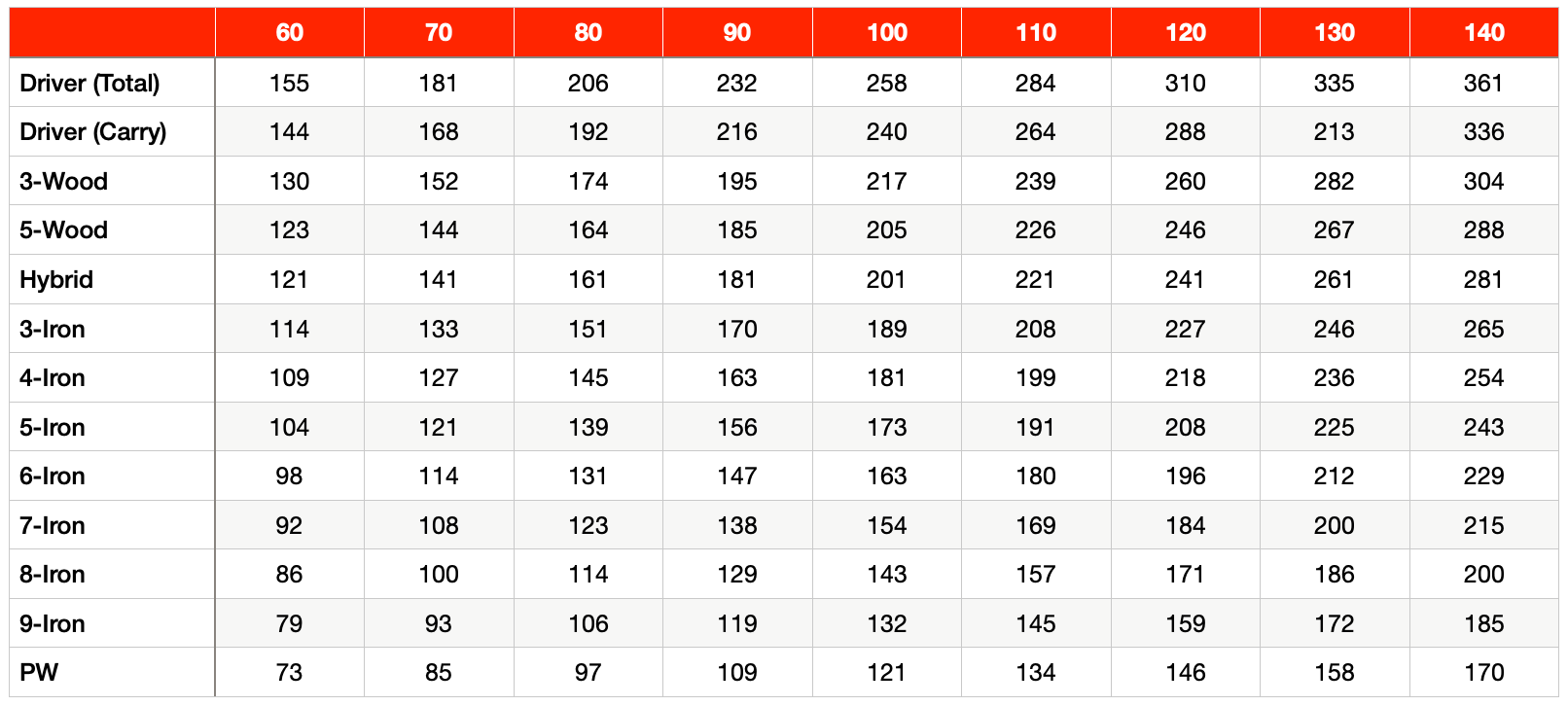
This can be used as a benchmark as to how far you should be able to hit each club…
But while it’s fun to try and smash the ball as far as you can, when you’re just starting out, it’s more important to focus on making consistently solid contact and keeping the ball in play.
Golf Balls for Beginners: All You Need To Know
On the surface, most golf balls look exactly the same.
However, how the ball is constructed will affect its performance and price. Here’s what you need to know…
Types Of Golf Balls
In broad terms, there’s only 2 types of golf ball: distance and performance.
The main difference between the 2 is the number of pieces (or layers) used to construct the ball.
Distance Golf Balls
Have only 2-3 layers, with a solid inner core and hard cover.
These are designed to decrease side spin, allowing them to fly straighter through the air. The lack of spin will also enable the ball to run further upon landing.
Performance Golf Balls
Have 3-5 layers, with a softer outer cover.
Unlike the distance ball, performance balls allow a much greater degree of back spin, enabling the ball to carry further but roll less.
The performance ball is perfect for lower handicap players who can control the ball around the green and produce the desired amount of back spin for the shot they’re playing.
How To Choose The Best Golf Balls For Beginners
Distance balls are designed for beginners and players with slower swing speeds.
The decreased spin and ability for the ball to roll further will allow them to get closer to the green, even if they’ve not struck the ball out of the sweet spot (7).
Not only that, but these balls are more durable and less expensive.
Try to buy distance balls that are less than $20 for a dozen.
When you’re only losing a couple per round, you can upgrade to the more expensive, performance balls.
How To Play Golf for Beginners: The Learning Part
Golf is a target game, with the target usually being a fairway or a flag on the green.
Now, that might seem obvious, but if you overlook the importance of the correct set up,
you’re preparing to fail before you even swing a club.
So, if you want to make consistently solid contact, there are a few basic concepts you must understand and master.
How To Hold A Golf Club
The Grip
Widely considered one of the greatest ball-strikers of all time, Ben Hogan dedicated the first 23 pages of his book, “Five Lessons: The Modern Fundamentals of Golf”, specifically on how to grip the club – and for good reason…
Since your hands are the only connection to the golf club, it doesn’t matter if your takeaway is perfect, your swing is on plane, or if you shift your weight to your front leg…
If you have a faulty grip, the force generated during your swing won’t transfer to the ball via the clubhead, severely decreasing your carry distance (8).
Not only that, but how you position your hands on the club influences how the clubface is returned to the ball at impact and, therefore, the direction of the ball.
So let’s grip the club correctly…
How To Grip The Club
With the clubhead resting on the ground, place the middle of your left index finger and run the back of the club grip diagonally down to the bottom of your little finger.
Now, wrap your fingers round the club and close your hand directly on top.
Checkpoint:
- The palm of your left hand should be facing slightly inwards
- Your thumb and index finger should form a ‘V’ and point to your right shoulder
- You should be able to see the knuckles of your index and middle finger
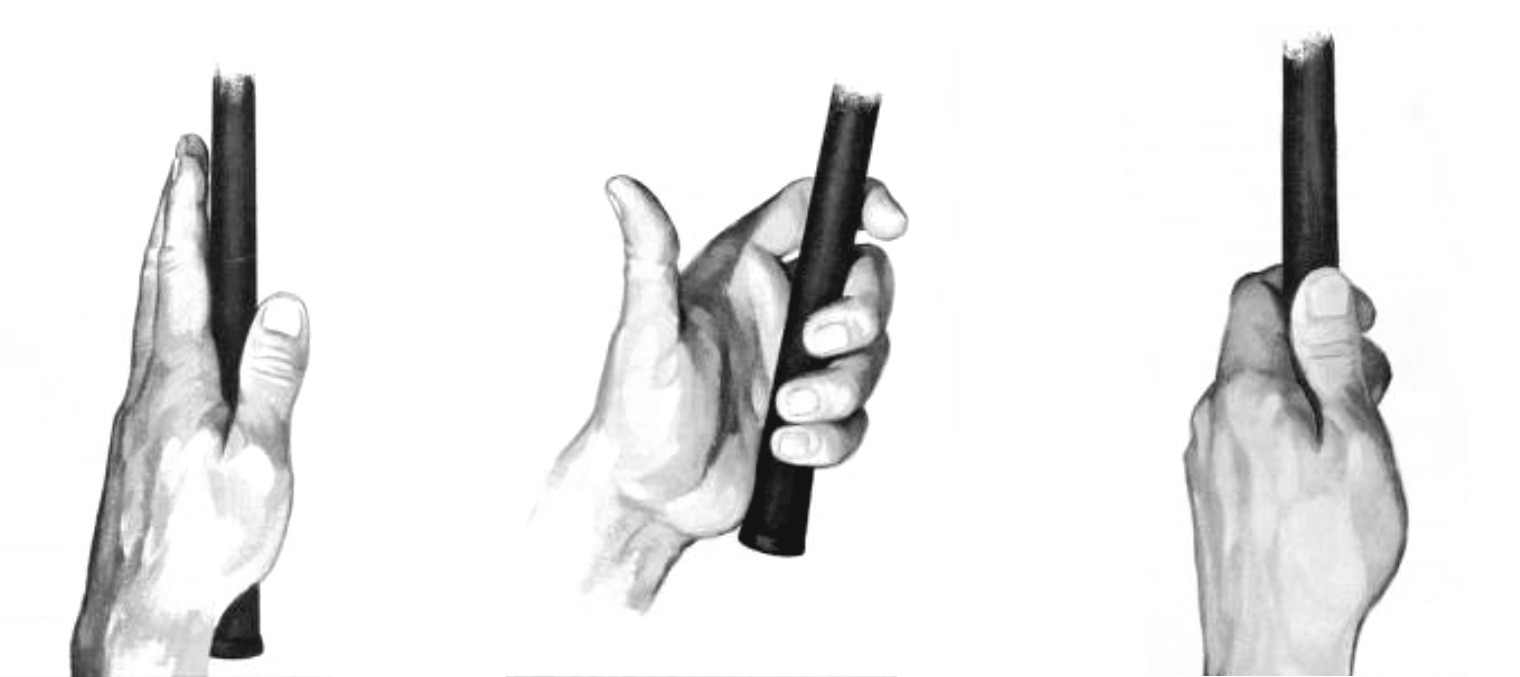
Next, place the fingers of your right hand around the back of the grip under your left hand, and close your right hand over – so that the thumb pad of your right hand is on top of your left thumb.
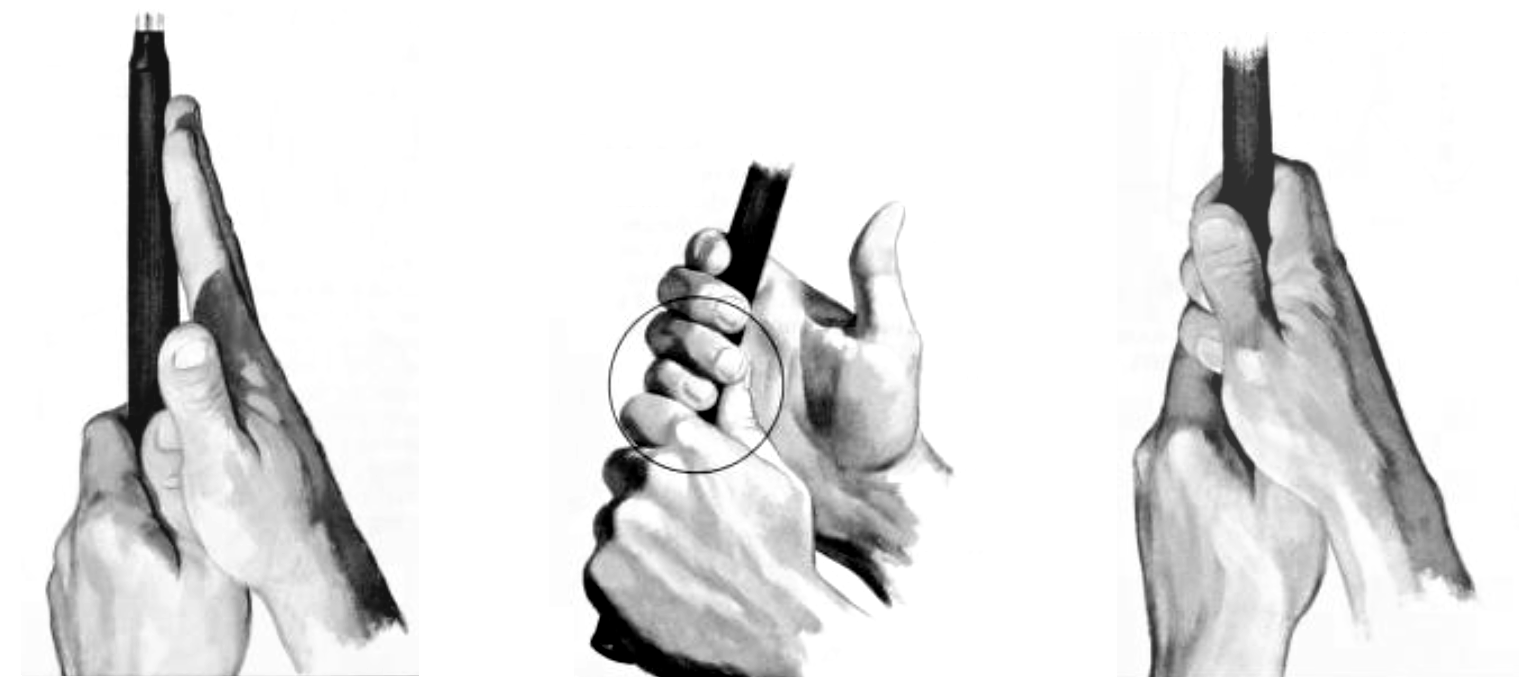
Checkpoint:
- Your thumb and index finger of your right hand should also form a ‘V’ and point to your right shoulder
At this point, don’t worry about overlapping or interlocking your fingers. Just set up with a 10 finger grip, unless you feel comfortable to do otherwise.
Practice Your Aim And Alignment
Now that you have the correct grip, you need to aim properly towards your target.
To do this, position the bottom of the club, known as the ‘leading edge’, at a 90 degree angle to the target you’re aiming at.
Next, simply align your body parallel to the target line you have created with the club, forming a ‘train track’ towards your target.
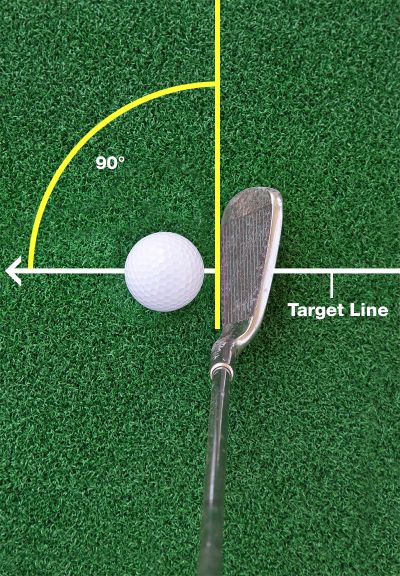
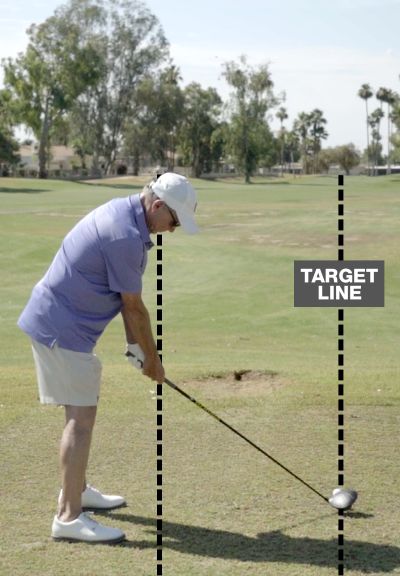
Stance & Posture
Have a slight bend in your knees and hinge your hips forward, allowing your arms to dangle naturally in front of you, while keeping your weight through the middle of your feet.
Your stance width and ball position will differ slightly from club-to-club. However, as a general guideline, have your feet shoulder width apart, distribute your weight evenly across both legs, and position the ball roughly in the middle of your stance.
Now that you’re set up correctly…
Here’s how to swing the golf club properly and strike the ball pure.
How To Swing A Golf Club
The golf swing is often overcomplicated and isn’t as difficult as it may seem.
You need only achieve the following 3 positions in your backswing, and the downswing will (almost) take care of itself:
- Keeping your arms straight, turn your body as if you were going to shake the hand of someone standing to your side, while keeping your feet facing forward
- At this point, hinge your wrists towards the sky, allowing your arms and club to form an ‘L’ shape.
- Now, continue turning your shoulders so the clubhead is pointing over your trail shoulder
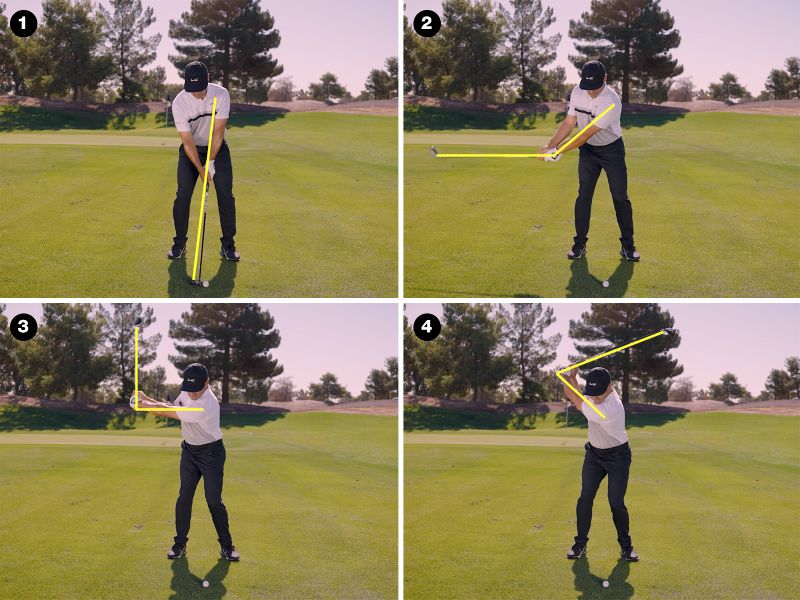
All you need to do now is unwind your body back towards the ball…
But in order to strike the ball flush every time, there’s an important concept you must understand.
Making Solid Ball Contact
To strike the ball far and high, you need to get ‘underneath’ it, right?
Wrong!
This is one of the most common mistakes beginner golfers make and is why it’s crucial to have the right swing concept from the start… before it ruins your scores, confidence, and motivation.
Instead, the lowest point (9) of your swing – meaning where your club brushes the ground – should be after you strike the ball.
See, golf clubs already contain a degree of loft and is why you see the best tour pros take a huge divot after the ball – because they’re hitting the ball first then the turf.
It’s critical to understand and master the low point of your golf swing if you want to make reliably flush contact with the ball.
So how do you put this into practice?
To perfect your low point at the driving range, lay a towel flat on the ground, about 4 golf ball widths behind the ball you’re going to hit.
The point of this drill is to miss the towel, striking the ball before the ground.
If you hit the towel first, you know you’ve hit the ground before the ball and can adjust for your next shot.
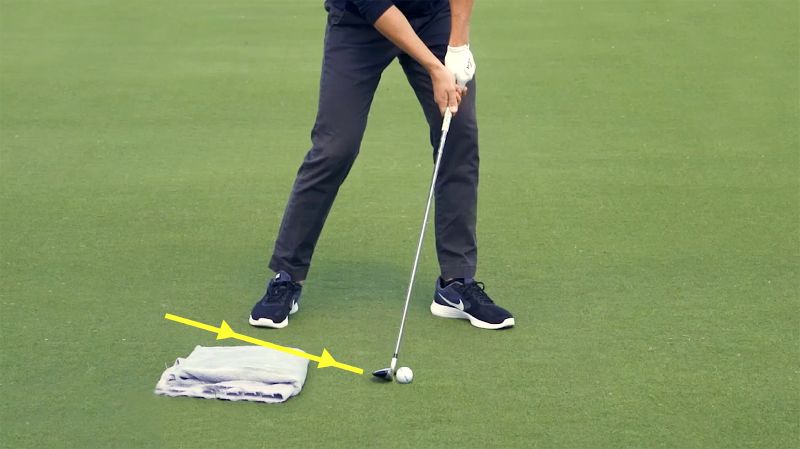
This is a great drill especially when hitting off range mats, as the quality of your ball striking can sometimes be misleading due to the club ‘gliding’ along the mat before making contact with the ball, resulting in what appears to be a good strike…
But would produce a ‘chunked’ shot on the course, with the ball trickling only 20 or 30 yards forward.
By using this drill and getting instant feedback on whether you’re striking the ground before or after you’ve hit the ball, you’ll naturally begin to shift your weight onto your front leg in the downswing in order for your low point to be after the ball.
Beginners’ Golf Shots You Need To Learn
There are an endless number of golf shots you could learn.
However there are only a few you require to consistently get you on the as little number of shots as possible.
Chip & Pitch
Almost 50% of your shots will come from on or around the green. Therefore, it’s vitally important you can confidently chip and pitch onto the green.
But what’s the difference between the two?
A chip comes out low, rolling farther than it flies.
And a pitch comes out high, flying further than it rolls.
A general guideline when choosing which shot to play is if there’s an obstacle in front of you, like a bunker, or even an elevated green, a pitch shot will often be a better option to fly the ball over the obstacle and stop it quickly on the green.
Bunker
Without knowing how to get out of a greenside bunker, your score can add up quickly!
See, this shot is different to every other shot you’ll make on the course, because you actually don’t want to hit the ball.
Instead, you want to hit 1-2 inches behind the ball, allowing the sand to push the ball out of the bunker.
But striking the sand slows down the clubhead a lot more than you’d expect, so the key to getting out the first time is ensuring you swing hard, follow through, and continue turning your body towards the target.
Punch Shot
Golf is as much about minimizing your errors as it is about hitting great shots.
As a beginner, it won’t be uncommon to miss the fairway and end up in the trees.
Instead of playing ‘hero’ ball and trying to reach the green from the woods, being able to hit a short, low flight, ‘punch’ shot will save you a lot of strokes and a lot of frustration.
More often than not you’re better to ‘take your medicine’ and punch out, knowing you’ll add an extra stroke to your scorecard rather than 3 or 4!
The Golf Course: How Do I Know I’m Ready For My First Round?
If you can answer ‘yes’ to the following questions, you’re likely ready to hit the course:
- Can I commit to a shot after only 1 or 2 practice swings?
- Am I able to make solid contact, without topping, shanking, or missing the ball entirely, on a regular basis?
- Am I able to get the ball airborne with several clubs?
- Am I reasonably confident chipping and pitching round the green?
When going out on the course for your first few rounds, if possible, try to go out with an experienced friend – this will really help you learn the correct golf etiquette and keep up with the pace of play.
And don’t worry about your score for the first few rounds. Instead, concentrate on making solid ball contact and playing high percentage shots – don’t try and play ‘hero ball’.
Booking A Tee Time
Without access to a private course, you’ll need to book a tee time on a public course.
Now, it’s natural to be a little nervous when playing your first few rounds.
So a good way to focus on your game (and not on your anxiety) is by playing at times the courses are less busy – which are typically early mornings, mid-afternoons, or late evenings.
A quick Google search for tee time aggregators are great for finding available tee times across multiple courses at once.
However, it’s always advisable to call the course directly to make sure there’s no events or leagues on during the time you’re looking to play, and that the course is suitable for beginners.
Golf Lessons: Do You Need Them?
By setting up correctly and getting immediate feedback using the drill described above, you’re well on your way to making consistent contact, making rapid progress, and building a repeatable & reliable golf swing.
However, if you’re looking to take golf a little more seriously from the start, lessons can be beneficial to ingrain good habits early in your learning journey.
If that sounds like you, you’ll want to find a coach who tailors lessons to you as an individual and who can simplify the golf swing – rather than following a one-size-fits-all approach or someone who overwhelms you with technical instruction.
The best way to find such a coach is to ask your friends if they’ve had a positive experience with an instructor who they’d recommend.
If you can’t get a recommendation, you can book in with a local pro, or Google search for the best instructors in your area to find a coach nearby.
Online Videos & Online Instruction
There is an abundance of golf tips online.
However, it’s easy to get into a state of paralysis by analysis trying to learn EVERYTHING about the golf swing, without putting any of it into practice.
Our advice would be to stick to one instructor or YouTube channel you like, and focus on practicing ONE thing at a time.
If you want a more structured and specific practice plan, but not with an in-person coach, an online coaching program is a great way to self-learn at lower cost.
You can learn more about our online learning programs for beginners here.
Conclusion & Key Takeaways
Golf doesn’t have to be complicated, confusing, or overwhelming.
Just remember these key points for learning how to play golf to keep it simple, effective, and fun:
- Set yourself up for success by adopting the correct grip, aim, and stance.
- Most amatuer golfers can’t self-correct after a bad shot. So, use drills and tools that give you immediate feedback so you can understand what you’re doing wrong and can self-correct.
- Focus on hitting the ball then the ground and making consistent contact with the center of the club face – master these two things and you will quickly become the envy of your golfing buddies.
- Practice with a purpose, focussing on only one or two things at a time.
- Borrow or buy only the essential equipment. Your money is better spent on improving your game rather than buying the latest gear.
- Try to play a course with a more experienced friend for your first few rounds. Don’t worry about your score, instead focus on the number of solid shots you make, and learn the appropriate etiquette.
And if you’re ready to accelerate your golf game, build a confident, reliable swing, and break 100, 90, or even 80, you can get started with one of our structured, expert training program(s) here.
Golf for Beginners: FAQs
What are the dos and don’ts for beginner golfers?
Do:
- Start on the driving range
- Practice your short game
- Learn how to grip the club properly
- Concentrate on making solid ball contact
- Take your time to set up and aim at your target
Don’t:
- Play your first round until you can consistently get the ball airborne
- Worry about anyone else when practicing at the range
- Focus solely on how hard and far you can hit the ball
- Set your expectations too high
How often should beginners practice golf?
Hitting 50 balls twice a week with a deliberate practice focus, and playing 9-18 holes every other week would be a great start and should ensure you see quick progress.
However, practicing consistently is more important than practicing intensely. For example, you’d be better hitting 50 balls 3 times per week rather than hitting 150 in one go.
A practice schedule you can stick to is most important in seeing continued improvement over time.
What are the best golf courses for beginners in the U.S.?
- 18 hole courses that are between 4,000 – 5,500 yards when playing from a forward set of tees.
- 9 hole par 3 courses
- Executive courses
How many golf lessons should beginners take?
As mentioned, lessons aren’t a necessity.
But if you do decide to take lessons, there’s no set number you should take – the most important thing to do is take at least 3-4 weeks between each lesson, so you can go out and practice what you’ve learned.
